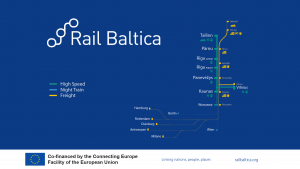11 March 2021, Rīga – the Rail Baltica joint venture RB Rail AS signed a contract with – TRT Trasporti e Territorio for the implementation of the Rail Baltica Transport Demand Model (hereinafter – DM). The total budget of this contract is 644 000 EUR, and the finalized model is expected by early 2022.
The primary objective of the Transport Demand Model is to forecast the passenger and freight demand for the Rail Baltica infrastructure for the first 30 years of operation. It will be used to predict the travel choice, including mode and routing, made by the passengers travelling with Rail Baltica. Such information will be used to calibrate and finalise Rail Baltica infrastructure design and operational planning. In addition, the model will support decision-making for numerous Rail Baltica activities, including cost-benefit and socio-economic analyses, environmental assessments, business, and financial planning. The development of the DM starts the next stage of Rail Baltica planning, and it builds on the body of knowledge and analysis conducted in the Cost-Benefit Analysis and Operational Plan.
The model will be delivered by TRT Trasporti e Territorio, a consulting company with an extensive experience in leading transport studies, including demand modeling exercises, such as TRIMODE, the pan-European multimodal transport model at the request of the European Commission. Their partnership with the German leading transport modeling consulting PTV CEE Sp. – the developer of VISUM, one of world’s most widely used integrated software platforms – guarantees first-class support for the Rail Baltica project.
As Rail Baltica joint venture RB Rail’s Transport Economist Dr. Stefano Manzo emphasizes: “Our next-generation transport demand model – to be developed together with highly experienced partners – will not only take the Rail Baltica commercial and operational planning to the next level, but aims to become the reference model for the entire Baltic region. As such, the model will be designed to also permit future functionality enhancements that would allow the testing of urban, regional as well as national mobility plans, thereby further promoting the connectivity and socio-economic development benefits that Rail Baltica will deliver for the Baltic region and beyond.”
Furthermore, the model will allow quantifying the likely impact of Rail Baltica line on the mobility in the Baltic States in the medium and long term. By engaging the relevant local and regional stakeholders, such as infrastructure managers and service providers from other modes of transport, municipalities, NGOs and other members of the wider mobility ecosystem, the project will promote potential synergies of the Rail Baltica project with the national mobility plans. In addition, it will identify the impacts that national and international transport and environmental policies may have on the future performance of the Rail Baltica economic corridor.
Special attention will be given to Rail Baltica passenger stations, both international and regional, and intermodal freight facilities, providing detailed passenger and freight flows. As a ‘live’ model that will be regularly updated in the future, the DM will help to optimize the size and scope of passenger stations as well as freight facilities. The model shall also provide critical information to future business partners, including service providers and investors, considering their future commercial engagements in Rail Baltica.

